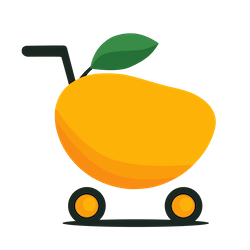A marketing funnel focuses on conversions. A customer journey focuses on long-term satisfaction. A marketing funnel is a structured process businesses use to guide prospects toward a purchase. In contrast, a customer journey maps every real experience and interaction a customer has with a brand, from first awareness to advocacy.
–
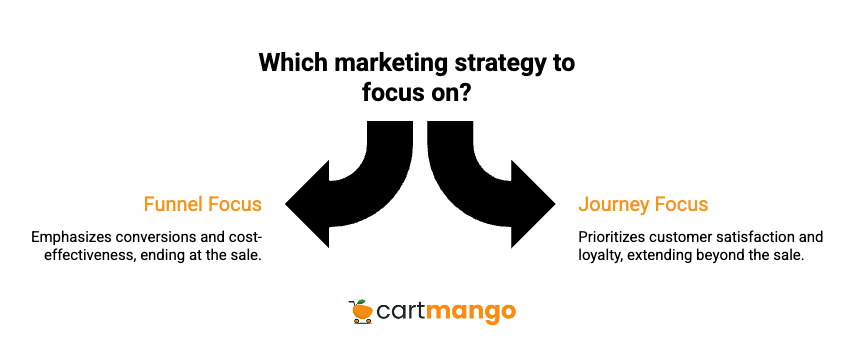
To choose the right process (marketing funnel or customer journey) for your goals, jump to this section.
–
What Makes Them Different
You might think a marketing funnel and a customer journey are just two terms for the same thing. They aren’t.
The funnel is what you want your prospects to do.
You design steps – like ad exposure, lead magnet, and sales page – to get someone to buy. The funnel moves in one direction and each step is controlled by your team.
The journey tells a messier story.
It’s what the customer really does, not what you expect. It includes moments when customers read a review, call a friend for feedback, abandon a cart, or even come back months later. The company can’t control every touch, feeling, or frustration.
- Funnels are about actions you want.
- Journeys are about experiences customers actually have.
Funnel focus: conversions.
You might track cost per acquisition (CPA), conversion rate, and average order value (AOV). To be clear, CPA is how much you spend to acquire one customer. AOV is the average a customer spends in one transaction.
Journey focus: satisfaction and loyalty.
You might look at Net Promoter Score (NPS) – which measures willingness to recommend your brand on a -100 to 100 scale – or Customer Satisfaction (CSAT), which is typically a percentage based on a simple ‘How satisfied are you?’ question after an interaction.
Funnels often end at the “sale.” Journeys don’t: they continue into onboarding, support, and advocacy.
The Marketing Funnel Explained
3 Stages of a Funnel
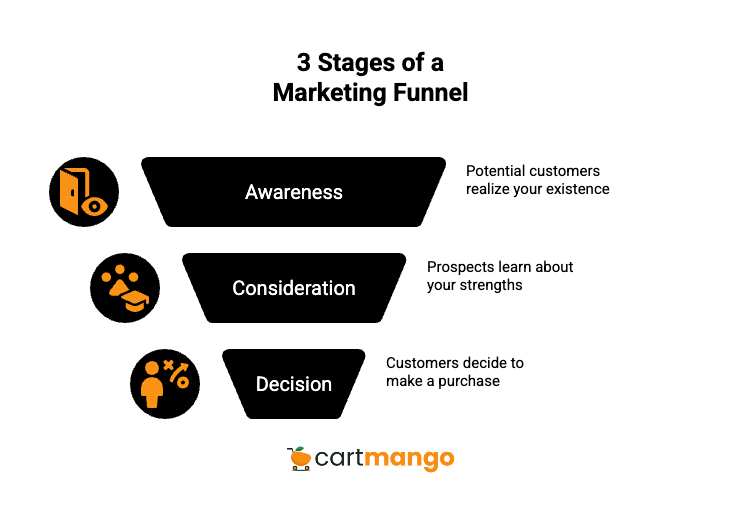
- Top of Funnel (TOFU) – Awareness. You run ads, create blog posts, or record podcasts. The goal: people realize you exist.
- Middle of Funnel (MOFU) – Consideration. You nurture leads through emails, webinars, and case studies. Prospects learn about your strengths.
- Bottom of Funnel (BOFU) – Decision. Now is the moment – testimonials, discounts, and calls close sales.
Every letter means something. TOFU builds recognition. MOFU educates and builds intent. BOFU asks for the sale.
Funnel Tactics
- At TOFU, try Meta or Google Ads, SEO content, and influencer partnerships.
- At MOFU, use targeted nurture campaigns, comparison tables, or video demos.
- At BOFU, rely on time-limited offers, 1:1 calls, and strong social proof.
The funnel gives clarity. If 1,000 people saw your ad, 100 visited your site, and 10 bought, you have a 10% click-through rate and 10% on-site conversion rate. You can see exactly where “leaks” cost you business.
Why Businesses Use Funnels
- You can forecast sales for investors and managers.
- It helps identify weak points in your offer.
- Funnels justify budget increases – or show where a cut is overdue.
- You can hand off leads from marketing to sales with clear triggers – e.g. after they download a demo or book a call.
A funnel isn’t just for e-commerce. B2B services, SaaS, coaches, and brick-and-mortar retailers all use funnels as a reliable forecasting and tracking tool.
The Customer Journey Explained
The Key Phases
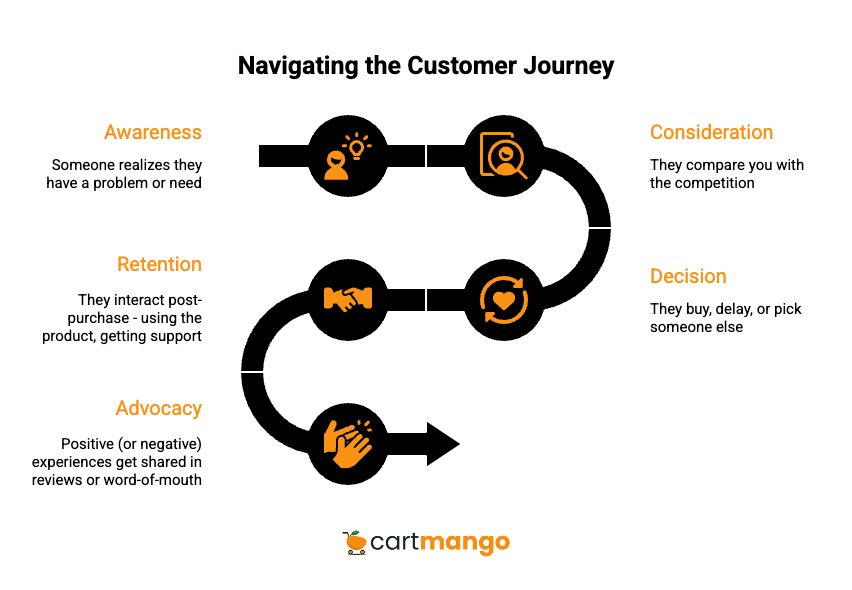
A typical customer journey includes these moments:
- Awareness: Someone realizes they have a problem or need.
- Consideration: They compare you with the competition.
- Decision: They buy, delay, or pick someone else.
- Retention: They interact post-purchase – using the product, getting support.
- Advocacy: Positive (or negative) experiences get shared in reviews or word-of-mouth.
Journeys are always multi-step, sometimes going backward. A buyer might hit “consideration,” even after a purchase, if they develop regret. That doesn’t fit neatly in a business funnel but happens regularly.
Customer Journey Touchpoints
Consider this: 89% of customers visit multiple websites during their research process before buying (source).
Every brand touchpoint matters. These include your homepage, mobile app, reviews left by other buyers, live chat, online communities, and every follow-up message.
Tracking Emotions: NPS and CSAT
Net Promoter Score (NPS) goes from -100 (no one recommends you) to 100 (everyone recommends you).
Most companies aim for 30 or above. Apple’s is over 50 (source).
Customer Satisfaction (CSAT) is measured as a percentage, calculated by dividing the number of satisfied customers by the total number of survey responses, then multiplying by 100. Aim for CSAT scores between 75% and 85%.
Collecting Feedback
The best journey maps aren’t done in isolation. Teams get feedback by:
- Surveying recent buyers about each step.
- Interviewing customers who abandoned carts.
- Reading support tickets for friction or confusion.
Doing this regularly improves the map.
Deep Diving Into The 5 Key Differences
Dimension | Marketing Funnel | Customer Journey |
|---|---|---|
Structure | Linear | Flexible, with looping/pauses |
Goal | Conversions and sales | Customer experience and loyalty |
Scope | Controlled, measurable, internal | All interactions, even those you don’t control |
Metrics | Conversion rates, CPA, AOV | NPS, CSAT, retention, churn |
Time Focus | 1–2 sales cycles | Multiple cycles or years |
Structure
Funnels follow a preset, linear path – each prospect starts at the top and moves step-by-step toward conversion. Your funnel could be as simple as: visitor clicks an ad, lands on a page, signs up for emails, then buys. Every prospect is expected to follow this route.
Real customer journeys don’t fit into neat stages. People move backward, skip around, and sometimes jump from awareness straight to advocacy if they’re influenced by social proof or a trusted friend. Some revisit steps, do more research, or decide later. Journeys account for this complexity.
Goal
Funnels optimize for conversion. Each piece is a nudge from not knowing your brand to making a purchase soon. The measures are immediate – how many leads converted, and how many sales were closed last week.
Journeys focus on customer experience over time. The goal isn’t just to get the sale but to keep people satisfied, coming back, and even referring others. Your primary concerns: will customers renew, re-buy, or leave positive feedback in 6 months?
Scope
Funnels center on areas you control: ads, website, calls-to-action, and landing pages. You monitor and adjust each bit.
Customer journeys include everything: Google search results, peer recommendations, reviews on social media, and even the way support interacts after a sale. If your support team handles problems well – or fails – that defines the customer’s journey, not just your funnel.
Metrics
Funnels use business-first numbers: cost per acquisition (CPA), average order value (AOV), conversion rates. You want to know: did someone buy, and was the process smooth?
Journeys are measured by emotional impact: Net Promoter Score (NPS), Customer Satisfaction (CSAT), and churn rate. A customer’s feeling about your brand can predict repeat business far better than quick sales data.
Time Focus
Funnels look at what’s happening now – how many conversions today or this month.
Journeys look ahead to months or years down the road. Are customers still buying? Do they recommend you, or are they quietly leaving? Loyal customers bring more value than constant new acquisition, making the journey essential for long-term success.
–
If you chase just funnel metrics, you risk big losses from churn or bad word-of-mouth. Acquiring a new customer costs between 5 and 25 times more than keeping one (source).
When to Use Each Approach (Marketing Funnel vs Customer Journey)
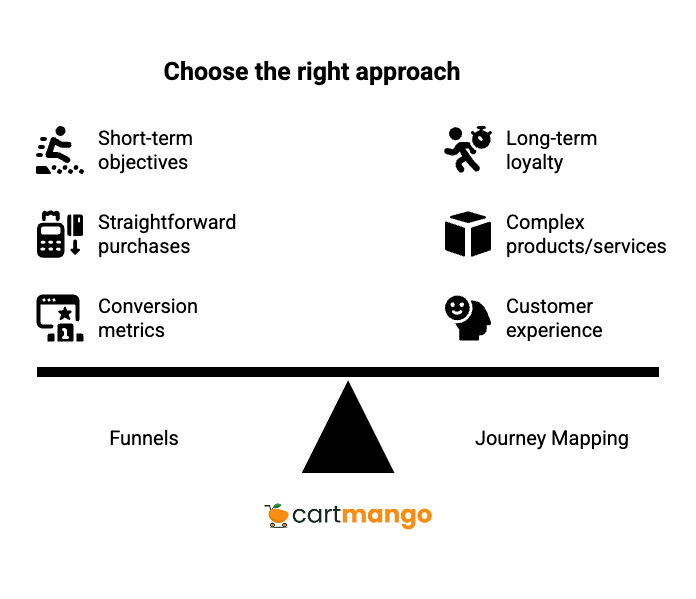
Scenario | Funnel | Journey | Both |
|---|---|---|---|
Product launch | ✓ | ||
Paid ad campaign | ✓ | ||
Lowering churn | ✓ | ||
Retention projects | ✓ | ||
Multichannel brand re-positioning | ✓ | ||
Major product revamp | ✓ |
When Funnels Work Best
A funnel is your go-to for measurable, short-term objectives.
You want new leads fast? Build a funnel that captures attention and converts visitors into prospects. Are you launching a product or testing a paid campaign? Start with funnel thinking – it gives you clear metrics on what’s working.
Funnels excel when you need predictable results. If you need conversion data or quarterly sales targets, funnel metrics provide concrete answers. They work well for straightforward purchases, especially when customers don’t need extensive research or support.
Use funnels for time-sensitive campaigns. Black Friday sales, limited-time offers, or product launches with deadlines benefit from the structured, linear approach. You control each step and can optimize quickly based on conversion rates.
When Journey Mapping Wins
You need journey mapping when customers are leaving after buying, giving poor reviews, or choosing competitors despite your strong funnel performance.
Journey maps reveal why people abandon your brand post-purchase or what causes negative sentiment.
Journey mapping shines for complex products or services. If customers need onboarding, training, or ongoing support, the journey approach helps you spot friction points that funnels miss entirely. B2B sales, software subscriptions, and high-consideration purchases all benefit from journey insights.
Use journeys when retention matters more than acquisition.
If your customer acquisition cost is high but lifetime value depends on renewals or repeat purchases, journey mapping shows you where to invest for long-term loyalty.
When Both Frameworks Together Make Sense
Cross-department projects need both approaches. A brand overhaul affects marketing (funnel metrics) and customer experience (journey satisfaction). Major product revamps require funnel efficiency for launches plus journey empathy for user adoption.
Use both when you’re scaling or entering new markets. The funnel drives initial growth while journey mapping ensures those new customers become advocates rather than one-time buyers.
How They Work Together
Funnels and journeys work together, not as competitors but as complements.
How does it look in practice?
You map your funnel stages – awareness, consideration, purchase.
You overlay the journey and see where the funnel doesn’t match reality.
For example, customers may drop off post-purchase due to onboarding friction. The funnel says “success,” but the journey screams “problem.”
Many users can leave because they don’t understand next steps. Solving this – maybe with a new welcome sequence – can lift both conversion and loyalty.
Team collaboration is smoother. Support shares post-sale frustration. Marketing and product teams work together fixing experience gaps.
Data sharing isn’t optional. You give everyone, from sales to support, access to customer feedback and funnel data. This way, no one is guessing.
The goal: minimize lost sales and unhappy customers. Brands with integrated funnel and journey view increase loyalty rates and reduce churn.
Implementation Tips
Step | Funnel | Journey | Tools |
|---|---|---|---|
Map stages | TOFU, MOFU, BOFU | Awareness, retention, advocacy | |
Set clear metrics | Conversion, CPA, AOV | NPS, CSAT, churn | |
Gather real customer input | Surveys | Interviews, feedback loops | |
Assign pain-point owners | Funnel marketers | Product/support specialists | |
Review & update quarterly | By metrics | By direct feedback | Dashboards, regular meetings |
How to Build Your Own
Start with your funnel. Use three stages at first. Map actions, offers, and conversion rates for each step. Don’t try to get too complex immediately.
Create a journey map next. Interview or survey at least 10–15 real buyers, focusing on what they did, what worked, and why they almost left. Avoid assumptions. Look for pain points in onboarding, slow shipping, unclear returns, missed expectations.
Set realistic metrics.
- Expect funnel conversion rates in the 2–5% range, not 20%.
- For NPS, don’t hope for Apple levels out of the gate; starting at +5 to +15 is realistic (source)
Review both maps together every quarter. Ask: Did conversion improve? Has CSAT gone up or down? Is churn dropping or did a change backfire?
Assign clear owners for each pain point in both systems. No point mapping friction if nobody takes charge of fixing it.
Tools are your friend. Miro for maps; Google Analytics for tracking; Typeform or SurveyMonkey for surveys and feedback; Trello for assignments.
Regular meetings (monthly or quarterly) keep both frameworks accurate.
The Marketing Funnel In Greater Detail
Building brand awareness is usually the first goal of a well structured marketing funnel.
You start at the awareness stage, introducing marketing materials and using marketing campaigns across digital marketing channels – like social media engagement or targeted ads. Social media sentiment analysis helps you see how customers interact and respond to initial awareness and marketing efforts.
At the interest stage, you focus on lead generation – converting leads into qualified leads by sharing exclusive deals, free trials, or useful content. Marketing automation can help ensure marketing efforts reach prospective customers at the right time with relevant offers.
The consideration stage is no time for guesswork. Your marketing funnel strategy should highlight customer pain points and address customer needs. This is where understanding customer pain points, and customer behavior becomes powerful. If your marketing strategy aligns with the entire customer journey, you move more potential customers toward becoming paying customers.
Pay close attention to customer interactions throughout the customer buying process. A customer centric approach means you’re watching customer satisfaction scores, gathering feedback, and refining every step so the customer journey model works for repeat purchases – not just the initial purchase. Customers decide when, where, and how to engage; your duty is to support them at every moment.
Customer acquisition cost is a real investment. Brands that emphasize customer loyalty and brand loyalty outperform those chasing short-term numbers. Satisfied customers do more than buy once – they return, refer, and become brand advocates.
Post purchase engagement is just as important as pre-sale tactics. Follow-up messages, check-ins, and exclusive offers for repeat customers all build long term relationships.
Data driven strategies – like social media sentiment analysis or analyzing customer satisfaction scores – let you continually improve sales efficiency, convert potential customers faster, and make the funnel and journey work together.
Most marketing funnels end at the final stage: the sale. But the real customer journey lies beyond initial purchase. Marketing channels, social media, and even free trials can keep customers engaged long after they first convert. When customers interact, buy, and return, you create a foundation for brand advocacy and lasting loyalty.
The customer journey offers much more than just sales. It takes the customer’s perspective and measures how to convert potential customers into satisfied customers who help build your reputation for years.
Common Mistakes to Avoid
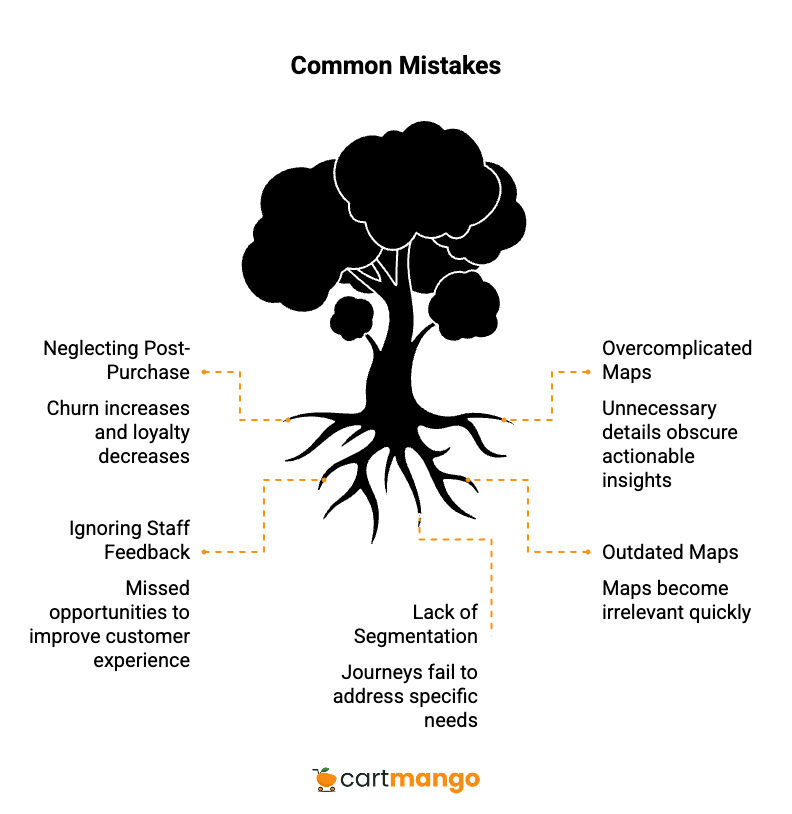
1/ Ignoring post-purchase experience
Brands that stop caring after the sale see higher churn and lower loyalty.
2/ Over-complicating journey maps
Don’t add every little interaction. Only map what you can or are willing to change.
3/ Not listening to frontline staff
Support and sales know where customers get stuck or frustrated. Use their feedback in your maps.
4/ Letting maps get outdated
What worked last year may not work now. New competitors, technologies, or policies can change the journey overnight.
5/ Not segmenting journeys
B2B and B2C paths don’t match. Enterprise customers have different key moments compared to individuals shopping online.
Marketing Funnel vs Customer Journey: Your Turn
A marketing funnel brings consistency and structure to the sales process, helping you convert more leads.
A customer journey ensures genuine understanding of every experience, building loyalty.
By updating both regularly and listening to real customer actions, you ensure long-term brand growth and strong retention.
Related Reading
- Sellfy vs Payhip: The Recurring Revenue Prison (2026)
- Podia vs Gumroad: The Recurring Revenue Handcuffs (2026)
- SendOwl vs Gumroad: The Recurring Revenue Black Hole (2026)
- Gumroad vs Sellfy: The Vendor Lock-in Cage (2025)
- Gumroad vs Payhip: The Hidden Trap for Creators (2025)
- ThriveCart vs SamCart – The Subscription Hostage Trap (2025)
- 8 ThriveCart Alternatives & The Lifetime Pricing Paradox (2025)
- 8 SamCart alternatives + Subscription hostage (2025)
- The GENTLE Method: Soft marketing for creators
- How Far in Advance Should You Promote a Webinar?
